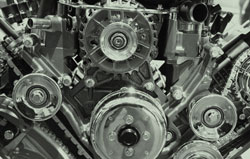Modelling tools for diesel engine manufacturers
Cavitation, the formation and subsequent rupturing of bubbles inside the cylinder chamber, can significantly shorten the expected lifetime of diesel engines. It also limits engine performance and causes unwanted air pollution. Engineers involved in the PREVERO project aimed to improve diesel engines by reducing cavitation and noxious emissions. In order to evaluate new cylinder designs and materials, it was necessary to develop a tool to estimate cavitation damage. This task was addressed by Le Laboratoire des Ecoulements Géophysiques et Industriels (LEGI) of the Centre National de la Recherche Scientifique (CNRS) in France. They used an empirical approach to establish the relationship between pit depth and the corresponding hydrodynamic load. This was then extended to an erosion model based on the pitting rate, mean pit diameter and the mean amplitude of impact loads. Fed with measurement data from the Laboratoire de Thermodynamique et Physico-Chimie Métallurgique (LTPCM), the model calculates a characteristic time for the entire exposed surface to become covered by non-overlapping pits as well as a characteristic length of the underlying hardened layer. The characteristic length and time are combined with a factor to produce the rate of erosion, denoted as the Mean Depth of Penetration Rate (MDPR). The incubation time can also be extrapolated from the characteristic time following adjustment for load amplitude. Application of the model during PREVERO revealed good agreement with laboratory measurements of actual mass loss. The model will be an invaluable tool to engineers for determining the effectiveness of new engine prototypes in combating cavitation.





